Learn
Pesticides
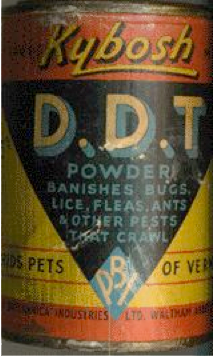 Pesticides kill, repel, or control certain plants or animal pests. There are many types of pesticides. Herbicides kill unwanted plants. Insecticdes kill unwanted insects. Fungicides prevent mold and mildew. Disinfectants prevent bacteria. There are also pesticides used to control mice and rats. Pesticides, however, also have their effect on humans, who are exposed to low levels of them in their food, homes, schools, hospitals, and workplaces. In general, pesticides affect human nervous systems.
Pesticides kill, repel, or control certain plants or animal pests. There are many types of pesticides. Herbicides kill unwanted plants. Insecticdes kill unwanted insects. Fungicides prevent mold and mildew. Disinfectants prevent bacteria. There are also pesticides used to control mice and rats. Pesticides, however, also have their effect on humans, who are exposed to low levels of them in their food, homes, schools, hospitals, and workplaces. In general, pesticides affect human nervous systems.
Rachel Carson wrote about pesticides in her book Silent Spring, and studied DDT (dichlorodiphenyltrichloroethane), an organic hydrocarbon (organochlorine) that is mostly banned now in the US. DDT was used to control agricultural pests like potato beetles, coddling moth, corn earthworm, cotton bollworm, and tobacco budworms. DDT also controls some insects with diseases like malaria and yellow fever. Carson argued that pesticides are bad for the environment because they rarely affect only the targets, claiming that they are “biocides.” They also bioaccumulate, or accumulate in organisms. Carson claims that the chemical industry knows that they are spreading false information and that the government is accepting it without second thoughts. She believes that in the future, effects would get worse when targets develop a resistance to these pesticides and weakened ecosystems collapse under invasive species. She believes that people should institute a more natural approach to dealing with pests. In June 1972 the US Environmental Protection Agency (EPA) stopped the use of DDT on crops.
However, DDT, though toxic, is not the worst organic hydrocarbon. Endrin (which was also banned by the EPA) and Dieldrin are highly toxic.
Coastal Ecosystems
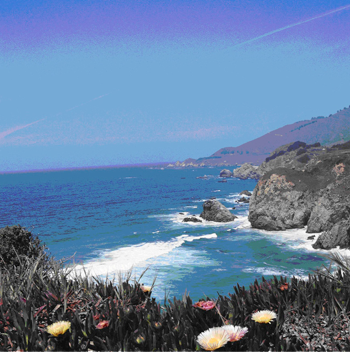 Coastal ecosystems occur where the sea meets the land. They include estuaries, coastal waters, lands located at the lower end of drainage basins, coa }stlines and adjacent lands, where streams and river systems meet the sea and are mixed by tides, rugged eroded headlands, sand dunes, sandy beaches, salt marshes, lagoons, or tidelands, freshwater wetlands, mangrove mud flats, coastal heath, seagrass beds, barrier islands, rocky shores, beaches and estuaries. These ecosystems are affected by the tides, waves, and wind, and include saline (salty water), brackish (mixed salty and fresh water), and fresh water. All these features interact with each other and are crucial to coastal fish and wildlife and their habitats. These ecological units are completed by a variety of plants. Enormous freshwater bodies, like the Great Lakes, play an ecological role similar to oceans, so are also counted as “coastal ecosystems.”
Coastal ecosystems occur where the sea meets the land. They include estuaries, coastal waters, lands located at the lower end of drainage basins, coa }stlines and adjacent lands, where streams and river systems meet the sea and are mixed by tides, rugged eroded headlands, sand dunes, sandy beaches, salt marshes, lagoons, or tidelands, freshwater wetlands, mangrove mud flats, coastal heath, seagrass beds, barrier islands, rocky shores, beaches and estuaries. These ecosystems are affected by the tides, waves, and wind, and include saline (salty water), brackish (mixed salty and fresh water), and fresh water. All these features interact with each other and are crucial to coastal fish and wildlife and their habitats. These ecological units are completed by a variety of plants. Enormous freshwater bodies, like the Great Lakes, play an ecological role similar to oceans, so are also counted as “coastal ecosystems.”
The coasts of the United States are extremely important habitats for fish and wildlife. Though they are less than ten percent of our land area, they provide much greater portions of resources. Much of our endangered and threatened species, like fish, migratory songbirds, and migrating and wintering waterfowl reside in these ecosystems. Human population growth has threatened these species. The US Fish and Wildlife Service has a Coastal Program that works to avoid further species decline.
Coastal ecosystems have many sections and types, corresponding to the variation of land along the coasts. 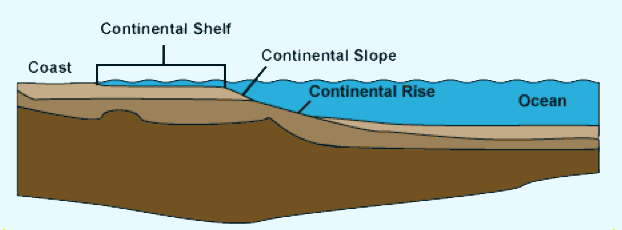
The beach is called the inter-tidal zone. It’s exposed between high tide and low tide, and is subject to very harsh and varied conditions. It could be covered twice and get pounded by waves and uncovered twice to be baked in a strong hot sun or frozen in frosty air all in a single day. These animals and plants have to adapt a lot. Seaweeds with regular exposure have a covering of mucilage to prevent desiccating (drying out) when the tide is out. They are exposed more the higher up the beach they grow, and become more resistant to drying out.
Rocky bays have very different conditions from these sandy beaches. They could have more or less exposure to winds and beach movement (longshore drift), more or less stable ground (rock does not move around much) and more or less inter-tidal pools (sand/shingle dries out quickly).
Rocky shores are fun to explore- rock pools give an underwater peek, and there is much wildlife. When the tide comes back these are immersed. The different parts of the shore have zones: the splash zone rarely flooded by the sea, the upper shore with much sun exposure, the middle shore where conditions are more mild, and the lower shore, where rock pools are, which are rarely exposed.


Mangroves are tropical/subtropical trees and shrubs that grow in brackish conditions. Though these mangal habitats are harsh, these plants manage to survive by avoiding the salt, taking in as much air as they can, and getting nutrients from the bacteria that thrive in this environment. Mangroves protect against erosion and provide a habitat for many.
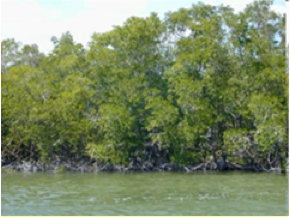
Other shore flora include sea grass, the only flowering plant that grows under the sea, and coral reefs. Mangroves, sea grass, and coral reefs are interdependent.
Rachel Carson wrote about this in many of her books.
Ocean Floor
Almost all continents have a continental shelf surrounding it, an extension of a landmass with shallow water. There is the most benthic (ocean-floor living) life here. As seen in the image, the continental slope slopes down and connects the shelf to the ocean crust. This with the shelf is called the continental margin. Submarine canyons cut through these. Then comes the continental rise, where sediments coming down the slope gather. The deep ocean basin has features like the abyssal plains (from a thick flat sediment layer), deep-sea trenches, and seamounts, formed by volcanoes. A mid-ocean ridge forms where two plates are moving apart and form mountains at each edge.
Wildlife is strange on the deep-sea ocean floor. They include tube worms, sea cucumbers, and spider crabs. Bacteria there thrive from geothermal vents.
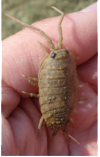
Fish Populations
Fish populations depend on the availability of food, how much they are fished, natural factors like predators and climate, and pollution. They are monitored to prevent endangerment and extinction. One of the fish Rachel Carson studied was muskellunge, a.k.a. muskie, a member of the pike family. It lives near the lake shore, and the loss of their habitat to human developments have harmed these. Over fishing has also had a huge effect, so people recommend catch-and-release fishing on these fish.
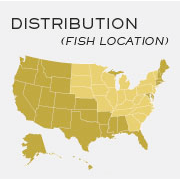

Zoology
Zoology, a part of biology, focuses on animals. Some zoologists may specialize and study certain forms of animals as well, while others may try to learn about the structure and function of animal bodies. One could also study in this branch how new animals are formed and how their traits are passed down. Zoologists study many interactions, like animals to each other, their environments, and the importance and meaning of these behaviors. The Ancient Greeks practiced zoology. Our primary animal classification system comes from Aristotle, with a few corrections. Charles Darwin also contributed greatly with his theory of evolution, since it showed how humans and animals could be related. We became part of the animal kingdom as well. With the microscope, modern zoology began. Later zoologists often studied animals in relation to humans, as Rachel Carson has with pesticides. Zoology is ever more diverse and complex, as zoologists learn more and more.
Zoology is a wide field that includes the structure of organisms all the way to the subcellular life. This descriptive and analytical science can be thought of as a basic science or as applied science. If basic, zoology deals with information about animals without further connections and applications. In contrast, applied zoology deals with facts that directly benefit humans. One example of this is in medicine.
Rachel Carson was a specialist in the marine biology branch of zoology. She is one of the most famous zoologists.